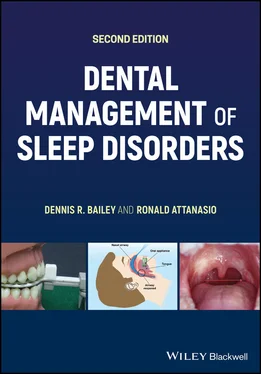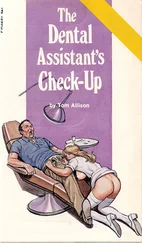Ronald Attanasio - Dental Management of Sleep Disorders
Здесь есть возможность читать онлайн «Ronald Attanasio - Dental Management of Sleep Disorders» — ознакомительный отрывок электронной книги совершенно бесплатно, а после прочтения отрывка купить полную версию. В некоторых случаях можно слушать аудио, скачать через торрент в формате fb2 и присутствует краткое содержание. Жанр: unrecognised, на английском языке. Описание произведения, (предисловие) а так же отзывы посетителей доступны на портале библиотеки ЛибКат.
- Название:Dental Management of Sleep Disorders
- Автор:
- Жанр:
- Год:неизвестен
- ISBN:нет данных
- Рейтинг книги:3 / 5. Голосов: 1
-
Избранное:Добавить в избранное
- Отзывы:
-
Ваша оценка:
- 60
- 1
- 2
- 3
- 4
- 5
Dental Management of Sleep Disorders: краткое содержание, описание и аннотация
Предлагаем к чтению аннотацию, описание, краткое содержание или предисловие (зависит от того, что написал сам автор книги «Dental Management of Sleep Disorders»). Если вы не нашли необходимую информацию о книге — напишите в комментариях, мы постараемся отыскать её.
Dental Management of Sleep Disorders
Dental Management of Sleep Disorders, Second Edition
Dental Management of Sleep Disorders — читать онлайн ознакомительный отрывок
Ниже представлен текст книги, разбитый по страницам. Система сохранения места последней прочитанной страницы, позволяет с удобством читать онлайн бесплатно книгу «Dental Management of Sleep Disorders», без необходимости каждый раз заново искать на чём Вы остановились. Поставьте закладку, и сможете в любой момент перейти на страницу, на которой закончили чтение.
Интервал:
Закладка:
The human tongue is a unique structure. The tongue functions as what is known as a muscular hydrostat [10]. This means that the tongue as a structure is filled with compressible liquid. As such the tongue can go through many different movements while always maintaining a constant volume. This explains how the tongue, especially the base of the tongue, when it is laying flat, has the potential to occupy more of the oropharynx and hence be a factor in airway compromise.
The Hyoid
This is an integral structure that supports the suprahyoid and infrahyoid muscles. The position of the hyoid relative to the mandibular plane is of importance as a reliable predictor of the risk for the SRBD when viewed on a cephalometric X‐ray. The more inferior the hyoid is from the mandibular plane the greater the risk for the SRBD (reviewed in Chapter 14). The muscles that relate to the hyoid no doubt control the position of the hyoid. This group of muscles is divided into two groups, the infrahyoids and the suprahyoids ( Table 3.3).
Table 3.3 Muscles related to the hyoid.
| Muscle | Action |
|---|---|
| Infrahyoids | |
| Omohyoid | Depresses hyoid |
| Sternohyoid | Depresses hyoid |
| Sternothyroid | Depresses larynx |
| Thyrohyoid | Depresses hyoid |
| Suprahyoids | |
| Stylohyoid | Elevates hyoid |
| Retracts hyoid | |
| Mylohyoid | Elevates hyoid |
| Elevates floor of mouth | |
| Digastric | Elevates hyoid |
| Aids in depression and retraction of mandible | |
| Geniohyoid | Helps move hyoid and tongue anteriorly |
Table 3.4 Muscles involved with the oropharynx.
| Muscle | Action |
|---|---|
| Superior constrictor | Constricts upper portion of pharynx |
| Middle constrictor | Constricts middle portion of pharynx |
| Inferior constrictor | Constricts lower portion of pharynx |
| Palatopharyngeus | Elevates pharynx |
| Helps close nasopharynx | |
| Salpingopharyngeus | Elevates upper and later portions of pharynx |
| Stylopharyngeus | Elevates pharynx |
| Expands sides of pharynx (dilates pharynx) |
The Hypopharynx
This is the area of the airway that is mostly unsupported and is subject to narrowing or collapse and that may be associated with the SRBD. The pharyngeal constrictor muscles function mainly during swallowing ( Table 3.4).
There are other muscles that need to be considered that involve mandibular function as well as the cervical spine. These muscles play a role in positioning of the mandible and the head and assist with maintaining the airway in the awake state and during sleep. The muscles that need to be considered are the Masseters, the Temporalis, and the Pterygoids, both lateral and medical. The muscles of the neck, both anterior and posterior, also need to be considered because they control head and neck position, and this in turn may have an impact on the airway. As an example, consider the principles of CPR as it relates to head position.
The two main muscles of the neck that are important, particularly with respiration, are the SCMs and the scalenes [11]. The SCMs and scalenes are considered accessory muscles to respiration. The primary purpose of the SCMs is to rotate and tilt the head as well as to cause flexion of the head. They also act as accessory muscles of respiration by elevating the sternum. The scalenes cause lateral flexion of the neck, and the anterior scalene specifically elevates the first rib and with respiration stabilizes the upper ribs.
The primary muscles of respiration during inspiration are the diaphragm and the external intercostals. During expiration the abdominal muscles and the internal intercostals are active.
In Summary
All of the muscles that have been discussed in some way play a role in maintaining the airway during respiration. During inspiration if the airway becomes compromised, then inspiratory pressures will elevate, and this will result in an increased negative pressure in the airway that will lead to further airway compromise as well as collapse. Many times the muscles that are intended to support the airway as well as tongue position can no longer maintain the airway, having become more relaxed, and further collapse is inevitable.
Nerve Supply to the Muscles of the Airway
To supplement the understanding of the airway it is also important to understand the nerves that supply the muscles of the upper airway ( Table 3.5).
To best facilitate this, the specific nerve that supplies the muscle is listed. It should be recognized that the muscles that are involved with respiration either are supplied by either cranial nerves or are nerves that originate from the cervical spine. For that reason, it is equally important that the evaluation of patients with the SRBD also has an evaluation of their posture, the cervical spine, and when indicated a cranial nerve screening evaluation.
An area of interest and concern is that there is also a neurologic basis related to SRBD. Neurologic considerations related to SRBD involve what is termed the upper airway reflex along with various neurologic conditions and neurogenic remodeling of the upper airway associated with repetitive mechanical trauma (snoring and apneas). The upper airway reflex impacts the tone of the airway musculature to limit or prevent collapse [12]. If this reflex does not adequately maintain the airway, then the possibility for airway collapse and for apnea to occur is more likely. This reflex may be both motor and sensory. In addition, neurogenic remodeling or changes associated with apnea may also occur [13]. These changes have been attributed to inflammation that occurs as well as vibrations associated mainly with snoring and hypoxia. These changes have been found to involve the hypoglossal nerve and the genioglossus muscle.
Previously a condition termed progressive snorers disease also contributed to neurogenic changes in the upper airway [14]. These changes were found to be present based on biopsies of the musculature in the palatopharyngeal area and were attributed to mechanical trauma associated with snoring, hence the recommendation to manage snoring as a preventive action. It has been found that there is an increased amount of inflammation associated with vibration in the airway associated with snoring [15], and this may result in carotid artery atherosclerosis [16].
Table 3.5 Nerve supply to the muscles of the upper airway.
Source : Adapted from Norton [7].
| Nerve | Supplies and innervates |
|---|---|
| Trigeminal CN V | Tensor veli palatini |
| Mylohyoid | |
| Anterior belly of digastric | |
| Masseter | |
| Medial/lateral pterygoids | |
| Temporalis | |
| Facial CN VII | Stylohyoid |
| Posterior belly of digastric | |
| Glossopharyngeal CN IX | Stylopharyngeus |
| Pharyngeal plexus from vagus CN X | Musculus uvulae |
| Palatoglossus | |
| Palatopharyngeus | |
| Cranial part of accessory CN XI | Palatopharyngeus ( possibly ) |
| Levator veli palatini | |
| Salpingopharyngeus | |
| Superior constrictor | |
| Middle constrictor | |
| Spinal accessory CN XI | Sternocleidomastoid (SCM) |
| Trapezius (along with C‐3 and C‐4 branches) | |
| Pharyngeal plexus – external laryngeal of vagus and recurrent | Inferior constrictor laryngeal of vagus |
| Hypoglossal CN XII | Genioglossus |
| Hyoglossus | |
| Styloglossus | |
| Superior longitudinal | |
| Inferior longitudinal | |
| Transverse | |
| Vertical | |
| C‐1 follows CN XII | Thyrohyoid |
| Geniohyoid | |
| Ansa cervicalis | Omohyoid |
| Motor component of cervical | Sternohyoid |
| Plexus (C‐1 to C‐4) | Sternothyroid |
| Ventral rami | |
| C‐4 to C‐6 | Anterior scalenes |
| C‐5 to C‐8 | Middle scalenes |
| C‐6 to C‐8 | Posterior scalenes |
| Phrenic nerve from C‐3 to C‐5 | Diaphragm |
Basics of Airway Dynamics
Интервал:
Закладка:
Похожие книги на «Dental Management of Sleep Disorders»
Представляем Вашему вниманию похожие книги на «Dental Management of Sleep Disorders» списком для выбора. Мы отобрали схожую по названию и смыслу литературу в надежде предоставить читателям больше вариантов отыскать новые, интересные, ещё непрочитанные произведения.
Обсуждение, отзывы о книге «Dental Management of Sleep Disorders» и просто собственные мнения читателей. Оставьте ваши комментарии, напишите, что Вы думаете о произведении, его смысле или главных героях. Укажите что конкретно понравилось, а что нет, и почему Вы так считаете.











